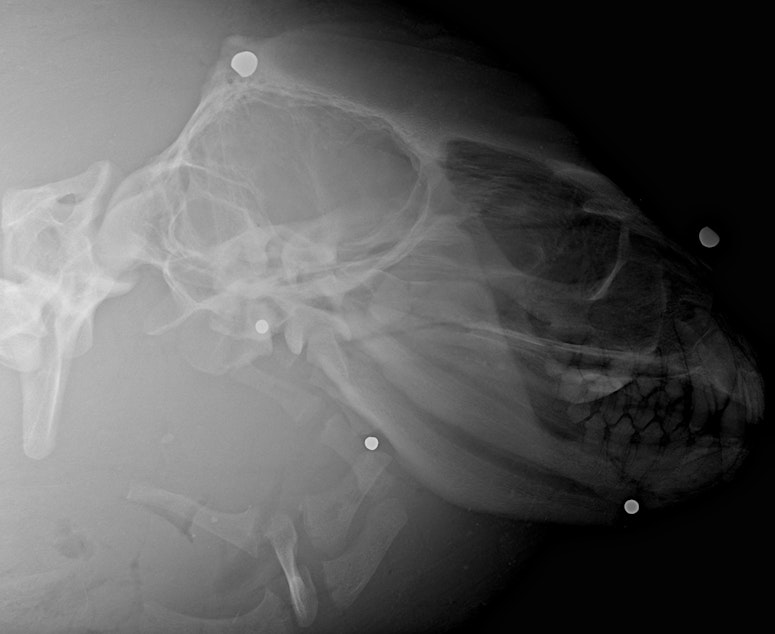More sea lions found dead with shotgun wounds in Seattle area

At least eight sea lions have washed up dead with bullet holes this fall in the Seattle area. The latest was found Sunday on Vashon Island.
On Tuesday, X-ray images confirmed it was another aquatic victim of a shotgun blast.
Five other sea lions have washed up with bullet wounds in West Seattle, and two on the Kitsap Peninsula.
Officials with the National Oceanic and Atmospheric Administration are asking the public for help investigating the crimes. They declined to say whether they have any suspects yet.
Some sea lions are shot each year, but this is an exceptionally high number, according to the Seal Sitters Marine Mammal Stranding Network. The volunteer group says the high season for sea lion shootings, December through Februrary, corresponds with the return of spawning salmon and the fishermen who chase them.
Male sea lions migrate up to the Pacific Northwest each fall after leaving their rookeries off Southern California.
Sponsored
NOAA spokesperson Michael Milstein said 16 sea lions have been found dead this year in Washington, including the eight known to have been shot. Just four had been found dead at this time last year.
Seals and sea lions have proliferated in Washington waters in recent decades, and some fishermen say the state needs to start going after them to save endangered orcas.
The marine mammals — and some fishermen — are all competing for the same chinook salmon to eat.
While the population of southern resident killer whales has been dwindling, populations of harbor seals and California sea lions have boomed in Puget Sound.
Their population explosion has led to conflicts with other fish-eaters, including humans and killer whales.
Sponsored
"We’ve seen Steller sea lions probably quadruple in number in my area, easily," Makah tribal chair Nate Tyler told Gov. Jay Inslee’s killer whale task force earlier this year. "We have footage, fishing in the ocean, where there’s 90 sea lions on one boat. I don’t know how much fish one sea lion eats per day. That’s what the killer whales are fighting for."
Seals and sea lions ate nearly 700 tons of Puget Sound chinook salmon in 2015, up from 75 tons in 1970, according to a study led by NOAA scientists.
The study, published last year in the Canadian Journal of Fisheries and Aquatic Sciences, found that the seals and sea lions caught twice as much chinook salmon as orcas did in 2015 — and about six times more than humans did.
Harbor seals ate much more salmon than the two species of sea lions (California and Steller) did.
Killing a seal or sea lion — or any marine mammal — violates the federal Marine Mammal Protection Act. Penalties can include up to $28,520 in fines and a year in prison.
Sponsored
Federal regulators have authorized states to remove or kill sea lions at the Bonneville Dam on the Columbia River and at Oregon’s Willamette Falls, where sea lions have been observed preying on threatened runs of chinook salmon and steelhead.
Gov. Inslee’s orca task force recommended removing more sea lions from the lower Columbia River to reduce their consumption of chinook salmon.
In Puget Sound and the Washington coast, the task force called only for more study of how much food seals and sea lions are taking out of the mouths of orcas.
According to the Canadian Journal of Fisheries and Aquatic Sciences study, harbor seal populations in Puget Sound mushroomed from 2,000 in 1970 to 15,000 in 1999 and fell back to 7,500 by 2015.
Despite that drop, Puget Sound still has some of the world’s densest populations of harbor seals.
Sponsored
“If we’re going to deal with the seals and sea lions, we’ve got to understand, yeah, it’s going to be ugly, but things are going to have to be managed,” Ron Garner with the recreational fishing group Puget Sound Anglers told the governor’s orca task force at its Anacortes meeting.
Biologist Michael Weiss with the Center for Whale Research said proposals to cull harbor seals were “scapegoating an entire species of animal.”
Weiss said transient killer whales — which eat seals, not fish, unlike salmon-eating resident orcas — were controlling seal populations. He said we should let mammal-hunting transient whales keep doing their thing: eating the small, flippered mammals that compete for food with the endangered orcas.




